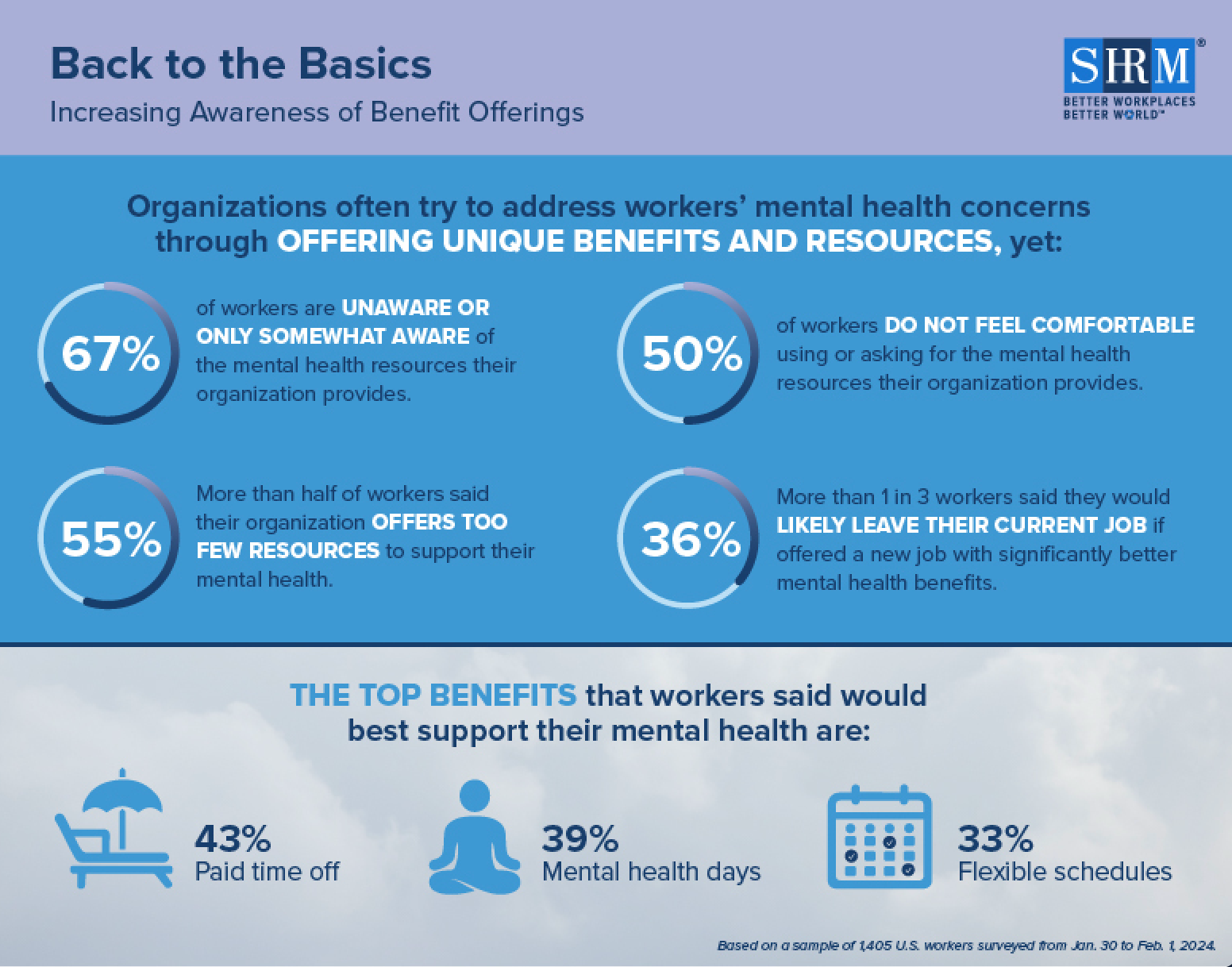Despite increased awareness and progressive policies like mental health days and access to counseling services, the stigma associated with experiencing mental health issues remains. Toxic workplaces can prevent employees from speaking up about their struggles or seeking help.
There also appears to be a gap between the mental health resources companies offer and the level of comfort employees feel in using these benefits. Employees often face obstacles preventing them from using the available resources, such as feelings of uncertainty, difficulty getting time off, and an overall lack of awareness of what’s offered.
Recent data from SHRM reveals that more than half of workers (55%) said their organization offers too few resources to support their mental health. This disconnect makes it difficult for organizations to support their workforce and communicates to individuals that their needs aren’t being taken seriously.
Address the Source of Distress
Mental health programs only serve as a bandage if the cause of employees’ distress is issues within their workplace.
“If [employers] have programs, but it’s a toxic workplace and employees work 80 hours a week for an irate, intense, disrespectful boss, that’s a bigger issue,” said Vicki Salemi, career expert for Monster. “The resources and systems in place are only effective when there’s a healthy work environment as a backbone—a strong, positive, solid foundation to support it.”
Leaders have an opportunity and responsibility to open up lines of communication and practice empathy by seeing the workplace from their employees’ point of view. Are they being bullied? Are managers overly demanding?
“Hosting routine trainings with leaders about mental health helps normalize and prioritize mental health in the workplace,” said Tanner Bergman, manager of well-being at Paycom. “After all, connecting with each other through empathy and listening is free.”
The Role That Culture Plays
According to SHRM’s data, 50 percent of workers do not feel comfortable using or asking for the mental health resources their organization provides.
If senior leaders and managers do not actively use or endorse these mental health programs, employees may view them as formalities rather than genuine support mechanisms. All talk and no walk, so to speak.
Similarly, a culture that prioritizes productivity over well-being can discourage employees from taking time off for mental health reasons. Individuals might feel guilty for taking a mental health day, worrying about the workload piling up in their inbox that they’ll have to make up for when they return.
Admitting to being a toxic workplace is tough for any organization. But instead of being ashamed by it, act on your awareness of the problem.
2 Key Questions Organizations Can Ask to Directly Address Toxicity
To address the fear that employees have of voicing their concerns, Salemi recommended collecting anonymous insights on internal factors that drive and sustain the toxic culture, then getting down to specifics.
Organizations should consider two key questions:
1. If a workplace is toxic, what specific aspects and leaders contribute to its toxicity?
2. What benefits programs, resources, and support can help your employees’ mental health after the toxic culture and leaders are rectified?
This gives employees an opportunity to be part of the solution by sharing their issues honestly without the stress of retaliation.
Expert Insights on the Top Benefits for Employee Mental Health
For those workplaces that are not suffering from toxicity, SHRM’s research shares additional insights, highlighting that 43 percent of workers would prefer more paid time off. More mental health days and flexible schedules also rank high.
However, organizations that implement these programs won’t know if they are effective unless employees use them. How can employers make sure workers are taking advantage of programs to support mental wellness?
“Employers and managers should ensure their policies are fair and encourage employees to use the time given to them, which may mean setting the example themselves,” Bergman said. “For complicated schedules or verifying business needs are met, managers can also automate the time-off approval process with great HR tech, replacing unnecessary barriers for employees with a simplified process.”
Richard Chaifetz, founder and CEO of ComPsych, said mental health is only one part of the wellness puzzle.
“In order to fully support and acknowledge employee mental health and well-being issues, organizations need to [also] support every aspect of their lives—financial, legal, caregiving, and everything in between. Just as important, organizational resiliency services such as training and critical incident support are essential to give managers and employees tools to overcome both day-to-day challenges as well as the needs of workers in the event of a traumatic incident.”
Organizations can offer meaningful support for employees’ mental health concerns by examining their work cultures for toxicity and eradicating it. Leaders who model measures to care for their own mental health will show employees that such behavior is not only accepted but also expected.

An organization run by AI is not a futuristic concept. Such technology is already a part of many workplaces and will continue to shape the labor market and HR. Here's how employers and employees can successfully manage generative AI and other AI-powered systems.




